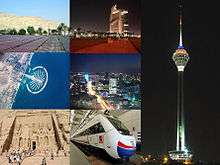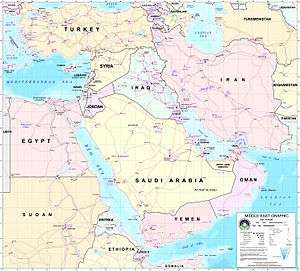Middle East economic integration
Policies advocating Middle East economic integration aim to bring about peace, stability, and prosperity in the Middle East, which they believe can only be sustained over the long run via regional economic cooperation.[1]

Background
Former U.S. Secretary of State Warren Christopher said that, "Governments can create the climate for economic growth...[but] only the private sector can produce a peace that will endure."[2]
Benefits of integration
Countries seek greater regional integration in order to:
- make economic welfare gains,
- increase the region's collective bargaining power in global issues, and
- maintain security and prevent conflict.
Economic integration requires good governance, education reform, social investing, knowledge economy, market economy, privatization and freedom of press.
Objectives

In 1993, Israeli Prime Minister Shimon Peres, a leading architect of the Oslo peace plan, envisioned that:[1]
The next stage, after bilateral and multilateral relationships have been established, will entail formation of regional industries through the cooperation of international bodies and independent international consortiums. At this point, the regional economic process will be upgraded and the new reality, in which business precedes politics, will be instituted. Ultimately, the Middle East will unite in a common market after we achieve peace. And the very existence of this common market will foster vital interests in maintaining peace over the long term.
Integration and peace
A prerequisite to economic integration is the establishment of peace. To date, several initiatives have enabled rapprochement among former enemies:
The Oslo Peace Accords and the 1994 Israel–Jordan peace treaty have promulgated greater economic interactions between Israel and its Arab neighbors. Despite this progress, problems like the Israeli–Palestinian conflict continue to be a hindrance to peace and development. Furthermore, the instability created by the war in Afghanistan, civil wars in Syria, Libya, Yemen and Egypt and the 2003 U.S. invasion of Iraq are considered negative factors to be overcome before the establishment of an economic union in this region.
Regional characteristics of MENA
- Despite many attempts since World War II to promote economic integration and political cooperation among states in the MENA region, economic interactions have remained limited. The scale of regional merchandise trade is limited, amounting to a mere 7–8% of total exports and imports. (For comparison, regional trade in Europe amounts to about 60%.)
| Intra-regional trade, (% of total trade) | EU | CEE+CIS | Asia | Africa | Middle East | Western hemisphere |
|---|---|---|---|---|---|---|
| Average (1991–97), source: International Monetary Fund | 62.1 | 29.6 | 36.8 | 9.0 | 7.1 | 18.3 |
- Capital transactions have also been relatively limited, with the exception of large official flows from the oil-exporting economies to other Arab countries, particularly after the 1973–4 and 1979–80 oil-price increases. Financiers estimate that up to US$2 trillion in investable assets originate in the Persian Gulf region, the bulk of which is parked abroad, often as American Treasury bills and in places like Switzerland and London.[3] Increasingly, however, Arabs are investing in their home region; governments are also spending billions on infrastructure and national investment agencies are looking for opportunities.
- Tourism and other non-factor service-flow patterns have been quite segmented. Some countries—primarily Egypt, Jordan, Lebanon, Morocco and Tunisia—have received substantial tourist flows from MENA countries. For others, particularly Israel, political and security considerations limit regional tourism.
- Labour flows have been important, taking the form of:
- Flows from non-oil economies to the Cooperation Council for the Arab States of the Gulf (GCC) economies, and
- Palestinian labour working in Israel. In the 1990s, these flows have been subject to major restrictions and there has been recent substitution of Asian labour for Arab labour in both cases. MENA does not have the kind of labour mobility found, for example, in the European Union, where the citizens of one country have the right to work in others.
- Other than the GCC and OPEC, there has been little in the way of regional economic policy coordination.
| MENA Region | 2009 | 2010 | 2011 |
|---|---|---|---|
| Real GDP growth | 2.8 | 3.6 | 4.5 |
| Real GDP growth (PPP) | 2.7 | 3.6 | 4.5 |
| Exports (change %) | −9.5 | 2.6 | 5.2 |
| Imports (change %) | 1.2 | 4.9 | 6.6 |
| CA (% of GDP) | −0.1 | 1.5 | 0.9 |
Initiatives for integration
Examples
- Council of Arab Economic Unity: Established in 1964, with the ultimate goal of achieving complete economic unity among its member states. An intermediate objective of customs union has been set for 2015.[5]
- Economic Cooperation Organization: Established in 1985. The common objective is to establish a single market for goods and services in West Asia, like the European Union.
- U.S.–Middle East Free Trade Area: Established in 2003 by the United States, this aimed to gradually increase trade and investment in the Middle East by assisting countries to implement domestic reforms and protecting private property rights.
- Euro-Mediterranean free trade area: The initial aim is to create a matrix of Free Trade Agreements. The next step would be a single free trade area of 600–800 million people, including, eventually, the European Union.
Challenges and opportunities
- Governance: Good governance attracts capital. Some Middle Eastern countries such as Saudi Arabia have made positive steps in reforming their judicial systems or adapting their capital market laws to international standards. Building efficient and capable public institutions needs to be a priority.
- Raise competitiveness levels of these economies. This can be achieved through overhauling and aggressively investing in the region's education system. If the education policies of the region deliver unwanted skills to the market, international investors will not be keen to come in, especially in the services sector. Unemployment runs as high as 40% in at least seven Arab nations.[5] Social investing should be planned in order to produce more entrepreneurs, engineers, scientists, and MBA graduates and expand the middle class.
- Raising competitiveness also entails accelerating the privatization programs, trade liberalization, investing in the infrastructure, deepening and linking capital markets and uprooting corruption.
- Facilitate the usage and penetration of new technologies. This would enhance the free flow of ideas, information and harness the forces of entrepreneurship. New technologies spur innovation and increase productivity which investors seek.
- Linked to this is increasing the freedom of the press and media which provides checks and balances against governments and business. New technology and freedom of the press would have a particular impact on youth and would encourage participation in the definition of future strategies at national and regional levels. Cooperation among Middle Eastern countries would be enhanced, advancing towards the knowledge economy. Increasing the use of new technologies would also reduce bureaucratic hurdles often cited by businesses as deterrents to investment.
See also
| Part of a series on the Israeli–Palestinian conflict | ||||||||||||||||||||||||||||
| Israeli–Palestinian peace process | ||||||||||||||||||||||||||||
|---|---|---|---|---|---|---|---|---|---|---|---|---|---|---|---|---|---|---|---|---|---|---|---|---|---|---|---|---|
 | ||||||||||||||||||||||||||||
|
History
|
||||||||||||||||||||||||||||
|
Primary concerns |
||||||||||||||||||||||||||||
|
Secondary concerns
|
||||||||||||||||||||||||||||
|
International brokers |
||||||||||||||||||||||||||||
- African Economic Community
- Arab Cooperation Council
- Arab Maghreb Union
- Arab Union
- Cooperation Council for the Arab States of the Gulf
- Council of Arab Economic Unity
- Economic integration
- Economy of the Arab League
- Economy of the Middle East
- Economy of the Organisation of Islamic Cooperation
- Euro-Mediterranean free trade area
- List of free trade agreements
- List of Trade blocs
- Middle East and globalization
- Middle East Economic Association
- Pan-Arabism
- Pan-Islamism
- South-South Cooperation
- U.S.–Middle East Free Trade Area
References
- Momani, Bessma (November 2007). "A Middle East Free Trade Area: Economic Interdependence and Peace Considered" (PDF). The World Economy. 30 (11): 1682–1700. doi:10.1111/j.1467-9701.2007.01036.x. Archived from the original (PDF) on 11 March 2012. Retrieved 12 June 2012.
- Christopher, Warren (1 December 2004). Prosperity in the New Middle East: Building the Structures of Peace, remarks made at the 1994 MENA Economic Summit. Casablanca, Morocco.
- http://www.middleeastconversation.org/?p=1749%5B%5D
- http://www.payvand.com/news/10/jan/1220.html
- "Business Articles - Arabs urged to speed up economic integration". The Daily Star. 2010-02-12. Retrieved 2010-02-25.
External links
- Middle East/North Africa Economic Summit
- Pulse of the Middle East - Al-Monitor
- MENA Report
- Trade policy and economic integration in the Middle East and North Africa By Hassan Hakimian, Jeffrey B. Nugent (2001)
- Globalisation and economic integration among Arab countries (1998)
- The "new Middle East" from the perspective of the old Middle East
- 2010 Economic Prospects for the Middle East and North Africa Region - World Bank
- Videos
